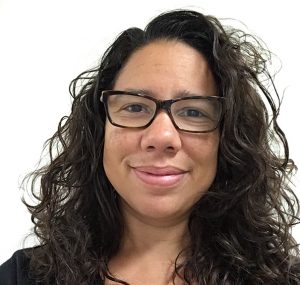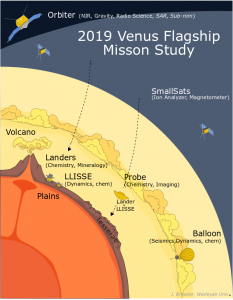NASA Funds Study of Gilmore’s Venus Mission Concept


Martha Gilmore, the George I. Seney Professor of Geology, professor of earth and environmental sciences, believes we have a lot to learn from studying Venus—yet the United States has not sent a mission to the Earth-sized planet since the early 1990s. That’s why Gilmore has proposed a major flagship mission concept study to assess whether Venus was ever a habitable planet by looking at its rocks and atmosphere.
In October, NASA agreed to fund the planetary mission concept on Venus submitted by Gilmore, a planetary geologist, and colleagues at several other institutions, who come from varied disciplines. Gilmore, who is the principal investigator, said NASA received 54 proposals and selected 10 to feed into the next Planetary Decadal Survey. Theirs was the only proposal on Venus to receive funding.
In 2020, the National Academy of Science will convene a panel of scientists and engineers to determine the scientific priorities for Planetary Science over the period 2023–2032. This Planetary Decadal Survey is conducted every 10 years and is tasked with recommending a portfolio of missions to NASA. The mission concepts that were funded will be developed for consideration by the Decadal Survey. In the coming months, Gilmore will be meeting and communicating regularly with her science team and conducting mission design runs at NASA’s Goddard Space Flight Center in Maryland. Final reports are due to the Decadal Survey in June 2020, and will describe mission architecture, cost, and how the mission will address the scientific priorities of the Decadal Survey and NASA.
Gilmore’s expertise is on the surface morphology and composition of Venus, Mars, and Earth, and her PhD focused on Venus during the United States’ Magellan mission. She explained that all three planets are rocky, and there is evidence that they all had oceans early in solar system history. Scientists believe that Mars’s ocean dried up first—within about one billion years—and that Venus’s ocean may have lasted for two or three billion years.
“Thus, for most of solar system history, there were two Earth-sized planets with oceans,” said Gilmore. “Was Venus habitable like the Earth and if so, what changed?”

Gilmore and colleagues have proposed a flagship-class mission concept, meaning it must be selected by NASA and is estimated to cost in the billions of dollars. They propose sending one orbiter, two orbiting SmallSats, two short-lived landers/probes, a balloon, and one long-lived lander to Venus to study its rocks and atmosphere. The goals outlined in the mission concept include understanding the history of volatiles and liquid water on Venus and determining if Venus was habitable; studying the composition of Venus’s surface and its implications for past and present climate; and studying the geologic history of Venus and how tectonically and volcanically active the planet is today.
The proposed mission “would provide major, unprecedented advancements in our understanding of the formation, evolution, and habitability of terrestrial planets,” Gilmore and her colleagues stated in a presentation they made at the 10th Moscow Solar System Symposium in October.
“One of the goals of humanity is to find another Earth,” said Gilmore. “It turns out that the most accessible and Earth-like planet in the galaxy is Venus. Venus helps us understand the conditions for habitability in our solar system and for the thousands of Earth-sized exoplanets we continue to discover. It’s time to go to Venus.”

